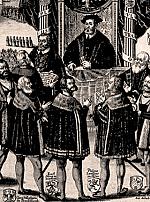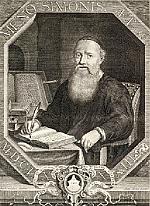A Joyful Noise
In my grandmother’s house there was an organ. It was an electric Hammond from the 1960s, the kind that whirrrrrrrred when you turned it on and whispered and clicked when you pushed the plastic keys. My brothers (who have grown up to be accomplished musicians) and I (who have not) all played it as children, stretching our legs far to reach the pedals and entertaining—and I’m sure occasionally annoying—the adults.
As the CHB staff discussed pictures for this issue, we were awed again and again by the magnificent organs Bach played. Organs seem, well, old-fashioned today, like petticoats and straight-backed wooden church pews. But they were the computers of the Baroque era, the epitome of complex craftsmanship, scientific precision, and cutting-edge technology. And Bach was their master.
For those who have come under its spell, Bach’s music is anything but old-fashioned. In our Winter 2005 issue, executive editor David Neff wrote of Bach’s impact on him: “I can still remember the first time I heard the creed sung as part of Bach’s magnificent Mass in B Minor. It was nearly 40 years ago at UCLA under the baton of Roger Wagner. The pain of Bach’s descending line in the Crucifixus (He was crucified) nearly moved me to tears, and then I wept with joy at the giddy shock of the brilliantly ascending Et Resurrexit (And rose again). Bach knew how to make theology sing.”
David himself is an organist and choir director at his church, and he’s not the only CHB staff member with musical interests. Emily LaHood plays the piano and guitar. I tried (and gave up) the violin a long time ago, flirted for a while with a viola da gamba, and now give private guitar and mandolin concerts for my dog, who usually hides. Doug Johnson and Rebecca Golossanov both met their spouses through music. Doug (an erstwhile drummer and bagpiper) met his wife (a mandolinist) when both were playing in a high school band. Rebecca’s father, a classical guitarist, introduced her to her future husband at a concert, and although Rebecca and her new acquaintance didn’t pay much attention to the music that night, she is almost certain her father was playing Bach.
With this issue we say a fond farewell (or at least, “See you ’round the hallways”) to Cindy Thomas, our editorial coordinator and social planner extraordinaire for the past two years. And we welcome to the CHB staff Becky Custer, who has provided administrative support to our sister pubs Christianity Today and Books & Culture for eight years, and who will lend royal dignity to our humble crew—she can trace her family genealogy back to Charlemagne. Oh yes, and she sings in the shower.
A round of applause for Calvin Stapert, our expert consultant who inspired us and provided us with a wealth of information about Bach.
By Jennifer Trafton
[Christian History originally published this article in Christian History Issue #95 in 2007]
Next articles
The Gospel Truth
Luther believed that music has the power to teach Christian doctrine. He put this belief into practice with his catechism hymns.
Mark NollChristian History Timeline: The Gospel According to Bach
The dates of Bach and important events preceding and following his life.
Paul Westermeyer and the editorsFrom Luther to the Lutherans
How a dynamic reform movement became a territorial church
David M. WhitfordFrom turmoil to peace
How Menno Simons and Pilgram Marpeck guided Anabaptists through troubled times
Mary S. Sprunger




